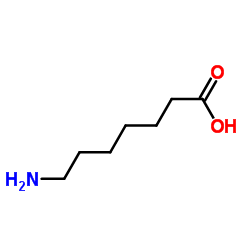7-Aminoheptanoic acid

7-Aminoheptanoic acid structure
|
Common Name | 7-Aminoheptanoic acid | ||
|---|---|---|---|---|
| CAS Number | 929-17-9 | Molecular Weight | 145.199 | |
| Density | 1.0±0.1 g/cm3 | Boiling Point | 270.6±23.0 °C at 760 mmHg | |
| Molecular Formula | C7H15NO2 | Melting Point | 192-195 °C(lit.) | |
| MSDS | Chinese USA | Flash Point | 117.5±22.6 °C | |
|
Development of imidazole alkanoic acids as mGAT3 selective GABA uptake inhibitors.
Eur. J. Med. Chem. 46 , 1483-98, (2011) A new series of potential GABA uptake inhibitors starting from of 1H-imidazol-4-ylacetic acid with the carboxylic acid side chain originating from different positions and varying in length have been synthesized and tested for the inhibitory potency at the fou... |
|
|
Surface interactions of a homologous series of alpha,omega-amino acids on colloidal silver and gold.
Biospectroscopy 5(1) , 9-17, (1999) Surface enhanced Raman spectroscopy (SERS) was used to characterize a homologous series of alpha,omega-amino acids on colloidal gold and silver. Raman and SER spectra of the alpha,omega-amino acids, NH2(CH2)nCOOH (n = 3-7), are presented and analyzed, reveali... |
|
|
Specific anionic residues of the recombinant kringle 2 domain of tissue-type plasminogen activator that are responsible for stabilization of its interaction with omega-amino acid ligands.
Biochemistry 32(14) , 3540-8, (1993) The involvement of specific aspartic acid (D) and glutamic acid (E) residues of the recombinant (r) kringle 2 (K2) domain of tissue-type plasminogen activator (tPA) in stabilizing its interaction with omega-amino acid ligands has been assessed by examination ... |
|
|
The cationic locus on the recombinant kringle 2 domain of tissue-type plasminogen activator that stabilizes its interaction with omega-amino acids.
Biochemistry 31(47) , 11698-706, (1992) The properties of the cationic locus within the recombinant (r) kringle 2 domain (residues 180-261) of tissue-type plasminogen activator ([K2tPA]) that are responsible for stabilization of its interaction with the carboxylate moiety of omega-amino acid ligand... |
|
|
Intravenous and oral administrations of DD2 [7-Amino-2-(sulfanylmethyl)heptanoic acid] produce thrombolysis through inhibition of plasma TAFIa in rats with tissue factor-induced microthrombosis.
Thromb. Res. 130(4) , e222-8, (2012) Thrombin-activatable fibrinolysis inhibitor (TAFI) is a plasma zymogen that is activated by thrombin in plasma. In fibrinolytic processes, carboxy-terminal lysine (Lys) residues in partially degraded fibrin are important sites for plasminogen binding and acti... |
|
|
Is there any need for a TAFI(a) inhibitor as thrombolytic drug?
Thromb. Res. 130(4) , 574-5, (2012)
|